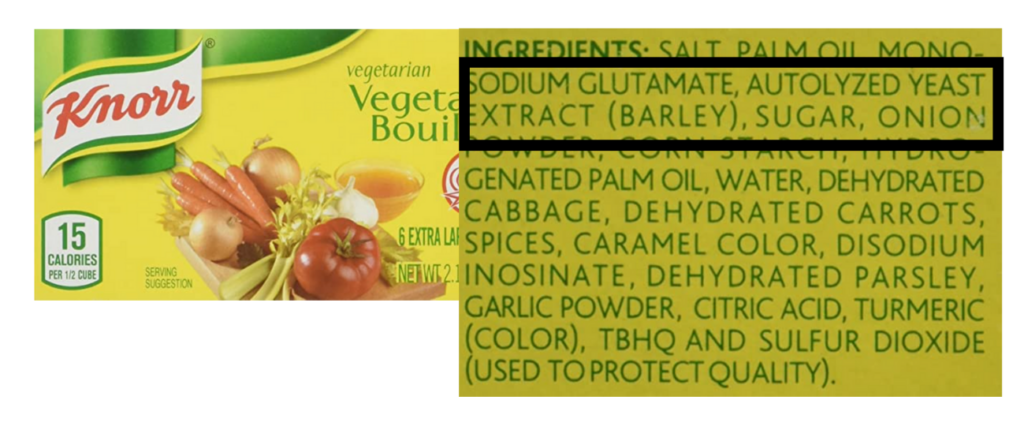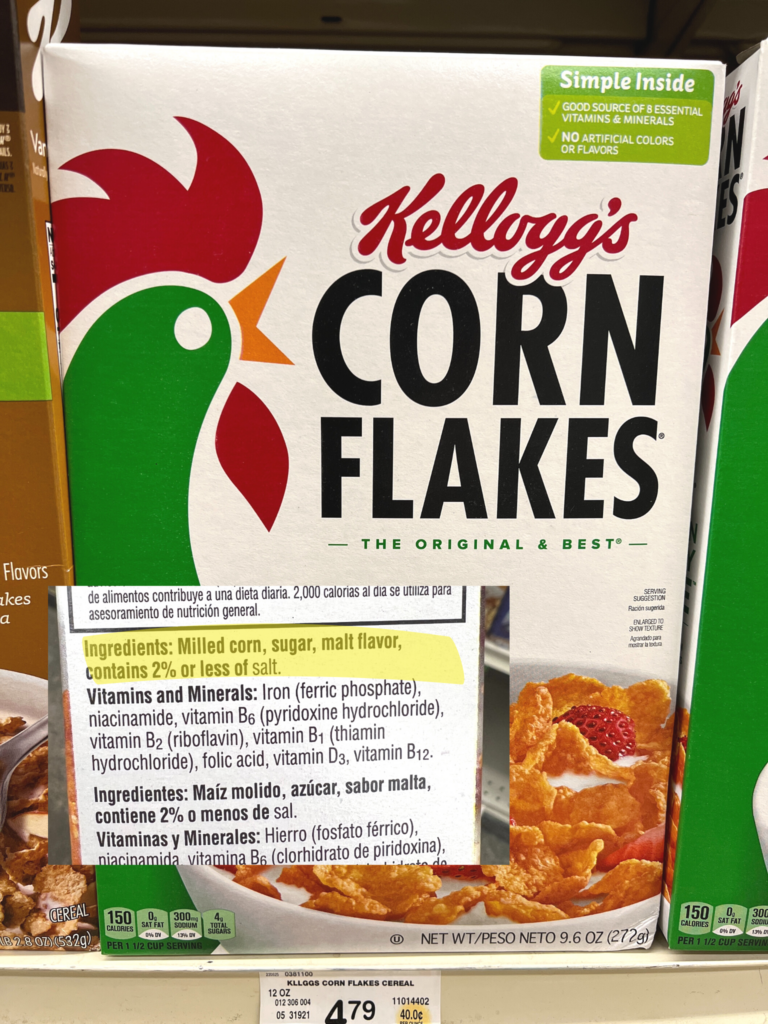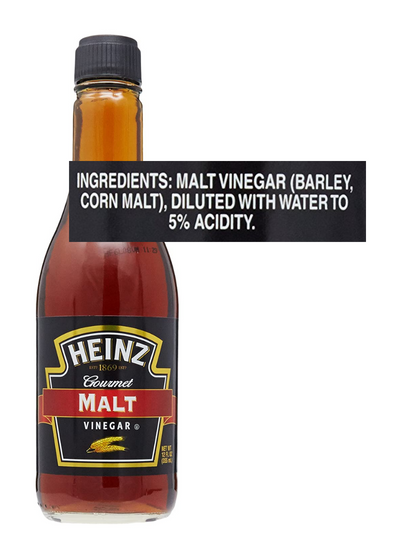
If you’ve been in the gluten-free community long enough, you’ve probably Googled, “Is malt gluten-free?” While you’ll find a myriad of answers to that question, you may not have realized the growing concern brewing over products containing malt and other potential sources of hidden barley. In this article, I discuss why barley is a concerning ingredient in food labeling and how you can protect yourself from getting glutened. This post may contain affiliate links. Please read my disclosures.
People on a gluten-free diet must avoid gluten, a protein found in wheat, barley, rye, and sometimes oats, and any product that might contain these ingredients or derivatives of them.
Unfortunately, gluten doesn’t always hide in plain sight. You can’t look at a product and know if it contains gluten, and it’s sometimes hidden in innocuous-sounding ingredients like brown rice syrup and yeast extract, which don’t overtly appear to be a source of wheat, rye, or barley.
In the U.S., under the Food Allergen Labeling and Consumer Protection Act (FALCPA), food manufacturers only must disclose if a product contains any of the top eight allergens – wheat, eggs, fish, shellfish, tree nuts, peanuts, dairy, and soy. They must do so in plain English either within the ingredient listing (e.g., water, flour (wheat), salt) or via a Contains statement (e.g., Contains: Wheat).
In other words, the U.S. does not classify barley as one of its top eight allergens, and therefore food manufacturers don’t need to disclose the “allergen” on their food labels. Conversely, Health Canada and the European Union require ALL sources of gluten, including wheat, barley, and rye, to be declared on a food label.
Given that barley can hide in vague-sounding ingredients, like malt and natural flavors, The Gluten-Free Watchdog advocates for adding barley as part of FALCPA so that food manufacturers would be required to disclose all sources of barley.
Potential Names of [Hidden] Barley
Unfortunately, without full-spectrum gluten labeling in the U.S., barley may lurk inside a food item that otherwise appears to be free from gluten. Some forms of hidden gluten that may be derived from barley include the following ingredients:
(1) Additives: This nebulous ingredient can contain many ingredients, one of which could be yeast extract. See Yeast Extract.
(2) Autolyzed Yeast Extract: Autolyzed yeast extract is a byproduct of the brewing process. It occurs when the enzymes inside the yeast are used to break down the proteins. See Yeast Extract.

(3) Artificial Flavors: The National Celiac Association says artificial flavors are gluten-free, but The Gluten-Free Watchdog includes the ingredient as a potential source of hidden barley. I’ve been unable to confirm which is true, so if you see the ingredient, look for other clues, like a gluten-free label, to assess if the product is free from gluten.
(4) Beer: Beer contains malted barley, which is a brewer’s preferred grain for making beer.
(5) Brewer’s Yeast: Brewer’s yeast is known as spent yeast or spent brewer’s yeast. It’s a byproduct of beer production. It may contain malt or other gluten-containing grains. See Yeast Extract.
(6) Brown Rice Syrup: Brown rice syrup may sound like its only ingredient is brown rice, which is naturally gluten-free, but sadly it isn’t so. Manufacturers sometimes use barley enzymes to break down the starch into sugar. Look for clues on the label (e.g., a gluten-free label) to determine if the ingredient is safe.
(7) Coffee Substitutes: Many coffee substitutes, like Kafree, Pero, and Cafix, contain barley or malt ingredients. The vast majority of coffee is gluten-free, which I explore in greater detail in this article.
(8) Dried Brewer’s Yeast: In making dried brewer’s yeast, yeast extract is dried, and the bitterness is removed, so it’s palatable for human consumption. See Yeast Extract.
(9) Dry Smoke Flavor: Dry Smoke Powder adds flavor to many snack foods. Food Ingredients Online says manufacturers may use a carrier ingredient, such as corn flour or barley malt flour, to capture the smoke flavor. Most liquid smoke brands, however, are gluten-free, including Colgin Liquid Smoke and Wright’s Liquid Smoke. A product label that includes mesquite, hickory, and hardwood smoke flavors requires further investigation to determine its safety.
(10) Energy Drinks: Some energy drinks contain malt, like Power Malt Energy Drink and Robusto. Monster will soon launch its The Beast Unleashed malted energy drink in 2023.
(11) Hydrolyzed Yeast Extract: Hydrolyzed means enzymes were added to the yeast to help break down the proteins. See Yeast Extract.
(12) Malt (malt extract, malt syrup, malt vinegar, malt flavor, etc.): Malt is a flavoring agent most likely derived from barley, although it can sometimes be derived from corn. Rice Krispies and Corn Flakes, for example, contain malt flavoring and are not gluten-free.

(13) Malt Balls: Malt balls, such as Whoppers, are made with malt made from gluten grains (barley) and are not gluten-free.
(14) Malt Vinegar: See Vinegar.
(15) Milkshakes: Many milkshakes are made with malted milk powder, an ingredient in Ovaltine (malt extract), and Nestle Carnation Malted Milk Powder (wheat and barley).
(16) Natural Flavors: This innocuous ingredient can mean many things, one of which could include yeast extract. See Yeast Extract.
(17) Natural Food Additives: See Additives.
(18) Rice Syrup: See Brown Rice Syrup.
(19) Tea Substitutes: Dandy Blend tea substitute touts that it’s gluten-free even though it contains roasted barley (and rye) extracts. The company says the barley is extracted with water and produces no malt. The company shares the results of its sandwich ELISA test, which detected no gluten. I’m unaware of other tea substitutes containing barley and NOT labeled gluten-free, but my guard is up.
(20) Vinegar: Distilled vinegar is gluten-free unless it contains malt flavoring; however, malt vinegar, found in chips and other savory foods, contains barley.

(21) Yeast Extract: Yeast extract is extracted from brewer’s yeast used to make beer and adds a savory flavor to a product. Yeast extract almost always contains gluten.
British spreads, like Vegemite and Marmite, contain yeast extract. Many bouillon products, canned soups, gravy mixes, snack foods, processed meats, BBQ sauces, and even some cosmetics contain yeast extract. The FDA says yeast extract should be clearly identified on the label and cannot be hidden under ambiguous terms such as natural or artificial flavoring.
Please note that yeast, an ingredient used to aid in the rise of bread and other baked goods, is gluten-free and should not be confused with “yeast extract.”
A Word About Barley Grass
Barley grass might be gluten-free only if the producer picked the plant before it sprouted and produced seeds. Only buy barley grass from companies that test their products for gluten and add a “gluten-free” claim to their label. Read more in my article, Are Wheatgrass and Barley Grass Gluten Free?

How to Protect Yourself from Hidden Barley Sources
Until the U.S. requires food manufacturers to disclose barley on their ingredient labels, the gluten-free community must be extra vigilant when reading and trusting food labels.
(1) Read Labels Carefully: If you spot any of the hidden barley ingredients listed above, such as malt or yeast extract, take pause. Such products, unless labeled gluten-free, contain gluten.
Also, double-check the label before buying or eating any product, even if you’ve purchased that exact product 100+ times.
Manufacturers can change ingredients without notice, as discussed in my article about formerly gluten-free products that now contain gluten. One company (Utz) removed a gluten-free claim from its label because it contained autolyzed yeast extract, which cannot be reliably tested for hidden gluten.
I recommend using the Fig App to help you quickly identify potential sources of hidden gluten in a product, and be sure to brush up on gluten-free labeling guidelines and laws.
(2) Be Extra Vigilant about Malt: Barley malt is a hydrolyzed food, which means the proteins have been degraded into smaller protein fragments. Current gluten testing methods, such as the sandwich ELISA test, require two epitopes or antibody binding sites to be accurate.
The Gluten-Free Dietician explains that a product that undergoes hydrolysis no longer has two epitopes or antibody-binding sites, which limits the accuracy of its testing capabilities and often underestimates the amount of gluten in a product.
A company producing a product that contains malt, even if labeled “gluten-free,” may not fully know the ppm of gluten inside the product. Even the FDA says there is no way to accurately test food for gluten when it has been partially broken down into smaller proteins, which occurs during hydrolyzation and fermentation.
(3) Don’t Trust Your Nima Sensor When Testing Malt: Nima is a gluten-detecting device that enables you to identify hidden gluten in the exact food you’re about to eat. It’s a valuable tool for helping the gluten-free community quickly identify hidden gluten in most foods.
However, one of Nima’s limitations is that it cannot detect gluten in hydrolyzed and fermented products, similar to the sandwich ELISA noted above.
You must read a label before testing it with a Nima to ensure the product contains no malt. I made the mistake of testing a product that contained barley malt (100 Grand candy bar), and Nima didn’t find any gluten. If I had read the label first, I would have known not to waste a capsule on testing a product that Nima has warned against testing. Lesson learned!
(4) Beware of Products Labeled “Wheat-Free”: Just because a product is labeled wheat-free doesn’t mean it’s gluten-free. Potato chips flavored with malt vinegar or barley malt would be wheat-free, but they certainly aren’t gluten-free. Read this article, Wheat Free vs. Gluten Free – What’s the Difference?, to learn more about how to protect yourself.

(5) Beware of U.S. Imported Foods: Remember, foods in Canada and the European Union require food manufacturers to disclose barley on a food label, but the U.S. only requires the disclosure of wheat. If you live in Canada or Europe, beware of U.S. imported foods.
While food manufacturers must abide by international labeling guidelines, the Canadian Food Inspection Agency (CFIA) temporarily suspended enforcement of certain food labeling requirements to relieve food shortages throughout Canada during Covid.
As a result, it’s possible that food imported into Canada and the EU from the U.S. was labeled with U.S. standards vs. Canadian and EU standards.
It’s a Journey
I promise to update this article as new information becomes available. If you find a product with a hidden barley source, please leave a comment or email me to let me know what it is so we can work together to share information with the greater gluten-free community.
Has anyone heard of Asia farm barley syrup and Delifru roasted barley syrup? There’s not many starch based barley syrups, and I don’t get how roasted grains can be used as a syrup material.
It’s for sure that mike’s hard/harder lemonade are barley based but has been furthur crafted to remove gluten. If it’s gluten free is unverifiable, so FDA has an opinion that common beers distilled can make a processed/crafted to remove gluten claim but can’t be labeled gluten free as gluten containing grain based beers. Gluten free grain based beers including sorghum beers can make a gluten free claim. I think a barley syrup should be made with barley starch rather than malted barley, when wheat starch is used to manufacture a wheat syrup (including glucose syrup/dextrose). If malt, malt extract/syrup, and malt vinegar has been furthur processed to remove gluten, maltose, maltose syrup, and distilled malt vinegar would be the ok ingredients and the properties of those foreign ingredients. The sprouted gluten of sprouted grains must be dissolveable with a sprouting process. So only distillation is a process to physically remove gluten.
I so appreciate what you do for the gluten free community! Thanks for this very informative article. Keep up the good work!